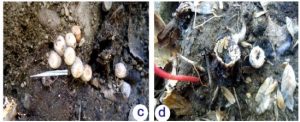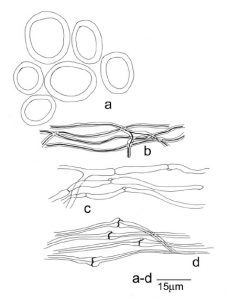Cyathus renweii T.X. Zhou & R.L. Zhao, in Zhou, Zhao, Zhao & Chen, Fungal Diversity 17: 245 (2004) Index Fungorum number: IF 371274
Peridium: obconic or vase shaped, 6–11 mm high, 5–8 mm wide at mouth, outer surface of peridium brownish, weakly plicate, covered with yellowish to yellowish-cream hairs and narrow tufts, becoming glabrous in age, inner surface silvery gray, strongly plicate only near the mouth; Peridioles: 8-14 in number, round, dark grayish, 1.5–2.0 mm in diameter and attached at the side of peridium by a funicular cord, cortex single; tunica brown, thick; Basidiospores: 15.2–33.6 × 10.4– 23.2 μm, L= 24.4±3.16 μm, W= 16.8±4.01μm, Q= 1.44-1.46, broadly ellipsoidal, ovoid (few), hyaline, double walled, inamyloid; Basidia: not observed; Exoperidial hyphae: 1.6–2.4 μm diam., hyaline, thick walled; Endoperidial hyphae: 2.4–8.0 μm diam., hyaline, thick walled, septate, branched, clamp connections present; Funiculus hyphae: 1.6–2.4 μm diam., hyaline, bulbous septate.
Materials examined: Jammu and Kashmir, Leh, Basgo village, humicolous, scattered, Rigzin Yangdol and Y. P. Sharma, HBJU–478, 24th August, 2013.
Distribution: Earlier reported from China (Zhou et al. 2004).
Notes: The macro- and microscopic characters of the present collection corroborates well with the taxonomic description given by Zhou et al. (2004). It is a new report for India.
FIGURE. c Young fruiting bodies of Cyathus renweii showing gregarious habit. d Young and mature fruiting bodies of Cyathus renweii in natural habitat.

FIGURE. Cyathus renweii. a Basidiospores. b Exoperidial hyphae. c Endoperidial hyphae. d Funiculus hyphae.

